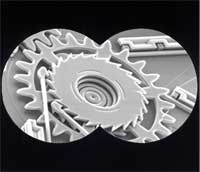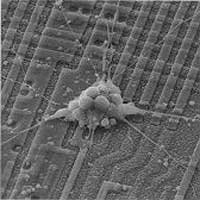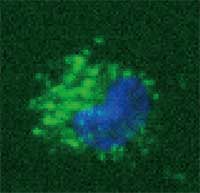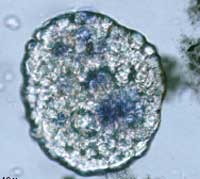Showing Spotlights 2497 - 2504 of 2851 in category All (newest first):
 Forecasting technological developments is notoriously tricky. Many futurologists choose a safe 50 to 100 years timeframe to make sure they are dead, and the book royalties spent, when the forecasts are due (or they skip the science part altogether and write science fiction). A few months ago we introduced you to a "Detailed Roadmap of the 21st Century", a year by year bullet point list of notable advances expected to happen in the 21st century. There is no wiggling out - the names of the people or organization making a forecast is attached to it. Already there are some missed forecasts - 8 out of 13 since 2001. Then there is another type of forecast, favored by some consultants and investment advisors, that attempts to predict the dollar value of product markets within a timeframe much shorter than that of futurologists and sci-fi writers. Although this group of forecasters develops elaborate models and methodologies, the outcome is equally dubious. A third type of forecast might be the most useful; here, the input comes from the group of people who live and breath the technology every day - the companies developing, building and selling products and services. Of course, the focus of this type of forecast necessarily becomes increasingly blurry as well as it looks into the future, but it tends to avoid the hyperbole and a lot of the speculative nature of other types of forecast. A recent UK study provides a purely industry-led forecast for nanotechnologies and examines industry's existing opinion of the economic potential for nanotechnologies.
Forecasting technological developments is notoriously tricky. Many futurologists choose a safe 50 to 100 years timeframe to make sure they are dead, and the book royalties spent, when the forecasts are due (or they skip the science part altogether and write science fiction). A few months ago we introduced you to a "Detailed Roadmap of the 21st Century", a year by year bullet point list of notable advances expected to happen in the 21st century. There is no wiggling out - the names of the people or organization making a forecast is attached to it. Already there are some missed forecasts - 8 out of 13 since 2001. Then there is another type of forecast, favored by some consultants and investment advisors, that attempts to predict the dollar value of product markets within a timeframe much shorter than that of futurologists and sci-fi writers. Although this group of forecasters develops elaborate models and methodologies, the outcome is equally dubious. A third type of forecast might be the most useful; here, the input comes from the group of people who live and breath the technology every day - the companies developing, building and selling products and services. Of course, the focus of this type of forecast necessarily becomes increasingly blurry as well as it looks into the future, but it tends to avoid the hyperbole and a lot of the speculative nature of other types of forecast. A recent UK study provides a purely industry-led forecast for nanotechnologies and examines industry's existing opinion of the economic potential for nanotechnologies.
Jul 23rd, 2007
 Back in January, when the U.S. president announced his hydrogen fuel initiative and proposed to spend a total of $1.7 billion over the next five years to develop hydrogen-powered fuel cells, hydrogen infrastructure and advanced automotive technologies, he said that it will be practical and cost-effective for large numbers of Americans to choose to use clean, hydrogen fuel cell vehicles by 2020. According to the U.S. Department of Energy's (DOE) Hydrogen Program, the government's goal is to achieve "technology readiness" by around 2015 in order to allow industry to make decisions on commercialization by then. That's only eight years to go. Given where the technology is today, this goal seems very ambitious, to say the least. Nanotechnology could help speed up the journey to the hydrogen society, but it will take some sensational breakthroughs on the way. The three key areas for the vehicles (we will not touch on the infrastructure issues here) are clean - the emphasis is on clean - hydrogen production, hydrogen storage, and the fuel cell itself. We'll take a look at how nanotechnology will play a role in these areas.
Back in January, when the U.S. president announced his hydrogen fuel initiative and proposed to spend a total of $1.7 billion over the next five years to develop hydrogen-powered fuel cells, hydrogen infrastructure and advanced automotive technologies, he said that it will be practical and cost-effective for large numbers of Americans to choose to use clean, hydrogen fuel cell vehicles by 2020. According to the U.S. Department of Energy's (DOE) Hydrogen Program, the government's goal is to achieve "technology readiness" by around 2015 in order to allow industry to make decisions on commercialization by then. That's only eight years to go. Given where the technology is today, this goal seems very ambitious, to say the least. Nanotechnology could help speed up the journey to the hydrogen society, but it will take some sensational breakthroughs on the way. The three key areas for the vehicles (we will not touch on the infrastructure issues here) are clean - the emphasis is on clean - hydrogen production, hydrogen storage, and the fuel cell itself. We'll take a look at how nanotechnology will play a role in these areas.
Jul 19th, 2007
 Following up on yesterday's Nanowerk Spotlight on nanobionics, today we'll look at bionics and other nanotechnology applications that could benefit disabled people. A range of applications and products with a combination of nanotechnology, biotechnology, and information technology are under development to directly improve the lives of people with severe injuries or medical conditions. Solutions range from better implants and prosthetics to brain-machine interfaces and they already are in the early stages of development and have working prototypes. While these are technical solutions to medical issues, and also a potential path towards transhumanist dreams, there is a number of social issues surrounding them that are rarely discussed. For instance, some 180 million young people between the ages of 10-24 live with a physical, sensory, intellectual or mental health disability significant enough to make a difference in their daily lives. The vast majority of these young people, some 150 million (80%) live in the developing world. They have limited access to education, employment and basic health care, and generally experience profound economic and social exclusion. The question needs to be asked whether the nano- and biotechnologies discussed to help the developing world are designed in a way to take into account the specific needs and realities of disabled people. Even if they did - and they do not - the next question is whether all these wonderful new technologies are really affordable for developing countries, or in other words: who pays for them? And finally, does the right social framework exist to take advantage of them?
Following up on yesterday's Nanowerk Spotlight on nanobionics, today we'll look at bionics and other nanotechnology applications that could benefit disabled people. A range of applications and products with a combination of nanotechnology, biotechnology, and information technology are under development to directly improve the lives of people with severe injuries or medical conditions. Solutions range from better implants and prosthetics to brain-machine interfaces and they already are in the early stages of development and have working prototypes. While these are technical solutions to medical issues, and also a potential path towards transhumanist dreams, there is a number of social issues surrounding them that are rarely discussed. For instance, some 180 million young people between the ages of 10-24 live with a physical, sensory, intellectual or mental health disability significant enough to make a difference in their daily lives. The vast majority of these young people, some 150 million (80%) live in the developing world. They have limited access to education, employment and basic health care, and generally experience profound economic and social exclusion. The question needs to be asked whether the nano- and biotechnologies discussed to help the developing world are designed in a way to take into account the specific needs and realities of disabled people. Even if they did - and they do not - the next question is whether all these wonderful new technologies are really affordable for developing countries, or in other words: who pays for them? And finally, does the right social framework exist to take advantage of them?
Jul 18th, 2007
 In case you are not old enough to remember the TV series The Six Million Dollar Man during the 1970s, the show was about an astronaut, Steve Austin, who got severely injured during a crash and became a guinea pig for bionics experiments by the CIA. In an operation that cost six million dollars, his right arm, both legs and the left eye are replaced by bionic (cybernetic) implants that vastly enhanced his strength, speed and vision. Never mind Hollywood, though, but bionics - a word formed from biology and electronics - has become a serious research field. In particular the development of artificial muscles is progressing rapidly. Nature's solution to producing fast contracting muscles is to use nanotechnology. The challenge for scientists is to mimic the intricacy of natural muscle in their artificial-muscle systems. As material scientists and engineers delve into the nanodomain, the boundaries between electronics and biology become fuzzy and this is exactly what they want: a seamless transition between the hard world of electronics and the soft world of biology.
In case you are not old enough to remember the TV series The Six Million Dollar Man during the 1970s, the show was about an astronaut, Steve Austin, who got severely injured during a crash and became a guinea pig for bionics experiments by the CIA. In an operation that cost six million dollars, his right arm, both legs and the left eye are replaced by bionic (cybernetic) implants that vastly enhanced his strength, speed and vision. Never mind Hollywood, though, but bionics - a word formed from biology and electronics - has become a serious research field. In particular the development of artificial muscles is progressing rapidly. Nature's solution to producing fast contracting muscles is to use nanotechnology. The challenge for scientists is to mimic the intricacy of natural muscle in their artificial-muscle systems. As material scientists and engineers delve into the nanodomain, the boundaries between electronics and biology become fuzzy and this is exactly what they want: a seamless transition between the hard world of electronics and the soft world of biology.
Jul 17th, 2007
 By now we all are aware of the issues concerning greenhouse gases and climate change, so there is no need to repeat them here. Rather, we will take a look at the areas where nanotechnologies could have a beneficial environmental impact - especially with regard to reducing greenhouse gases - above current technologies, and the barriers potentially preventing their adoption. A study commissioned by the nanotechnology group of the UK's Department for Environment Food and Rural Affairs (Defra) looked into the the policy implications of nanotechnologies that will benefit the environment. The report of the study, "Environmentally beneficial nanotechnologies: barriers and opportunities", investigates the opportunities and potential obstacles to adoption of a number applications of nanotechnology which could be used to cut use of non-renewable energy sources and reduce greenhouse gas emissions. Five nanotechnology applications were subject to detailed investigation: fuel additives, solar cells, the hydrogen economy, batteries and insulation.
By now we all are aware of the issues concerning greenhouse gases and climate change, so there is no need to repeat them here. Rather, we will take a look at the areas where nanotechnologies could have a beneficial environmental impact - especially with regard to reducing greenhouse gases - above current technologies, and the barriers potentially preventing their adoption. A study commissioned by the nanotechnology group of the UK's Department for Environment Food and Rural Affairs (Defra) looked into the the policy implications of nanotechnologies that will benefit the environment. The report of the study, "Environmentally beneficial nanotechnologies: barriers and opportunities", investigates the opportunities and potential obstacles to adoption of a number applications of nanotechnology which could be used to cut use of non-renewable energy sources and reduce greenhouse gas emissions. Five nanotechnology applications were subject to detailed investigation: fuel additives, solar cells, the hydrogen economy, batteries and insulation.
Jul 16th, 2007
 A quantum dot (QD), also called a nanocrystal, is a semiconductor nanostructure that can be as small as 2 to 10 nm. The usefulness of quantum dots comes from their peak emission frequency's extreme sensitivity - quantum mechanical in nature - to both the dot's size and composition. QDs have been touted as possible replacements for organic dyes in the imaging of biological systems, due to their excellent fluorescent properties, good chemical stability, broad excitation ranges and high photobleaching thresholds. However, the main drawback of QDs is their toxicity and therefore their application is problematic. If this toxicity problem could be addressed, QDs may one day be safely utilized in many areas. For instance, cadmium telluride (CdTe - which is toxic) QD based nanocomposites can be used as fluorescent probes for biological imaging, they can also be utilized to monitor targeted drug delivery and for controlled modification of structural and functional properties of intracellular components. Scientists in Ireland have been using gelatin during the production of CdTe QDs thereby reducing the toxicity of the particles. Their approach could be useful for the development of other nanoparticle composites with low toxicity as well.
A quantum dot (QD), also called a nanocrystal, is a semiconductor nanostructure that can be as small as 2 to 10 nm. The usefulness of quantum dots comes from their peak emission frequency's extreme sensitivity - quantum mechanical in nature - to both the dot's size and composition. QDs have been touted as possible replacements for organic dyes in the imaging of biological systems, due to their excellent fluorescent properties, good chemical stability, broad excitation ranges and high photobleaching thresholds. However, the main drawback of QDs is their toxicity and therefore their application is problematic. If this toxicity problem could be addressed, QDs may one day be safely utilized in many areas. For instance, cadmium telluride (CdTe - which is toxic) QD based nanocomposites can be used as fluorescent probes for biological imaging, they can also be utilized to monitor targeted drug delivery and for controlled modification of structural and functional properties of intracellular components. Scientists in Ireland have been using gelatin during the production of CdTe QDs thereby reducing the toxicity of the particles. Their approach could be useful for the development of other nanoparticle composites with low toxicity as well.
Jul 13th, 2007
 Our modern lifestyle exposes us to hundreds of chemical substances every day, quite a number of them are known to be hazardous, if not outright toxic. The long, long list ranges from toxic chemicals and heavy metals included in electronic waste to insecticides and herbicides that find their way into the food chain, to flame retardant chemicals in buildings and furniture. A European project has set out to give an overview of already used and conceivable applications of nanotechnology in order to replace hazardous chemicals. The overall idea behind this project is to identify new nanotechnology applications which could help to reduce the risks related to hazardous substances and chemical processes. Currently, nanotechnologies are not contributing exceptionally to an increase in the substitution of hazardous substances for safer ones. However, experts believe that this could well change in the future. These are two of the messages coming out of a study by STOA, the European Parliament's Scientific Technology Options Assessment committee, on the role of nanotechnology in chemical substitution.
Our modern lifestyle exposes us to hundreds of chemical substances every day, quite a number of them are known to be hazardous, if not outright toxic. The long, long list ranges from toxic chemicals and heavy metals included in electronic waste to insecticides and herbicides that find their way into the food chain, to flame retardant chemicals in buildings and furniture. A European project has set out to give an overview of already used and conceivable applications of nanotechnology in order to replace hazardous chemicals. The overall idea behind this project is to identify new nanotechnology applications which could help to reduce the risks related to hazardous substances and chemical processes. Currently, nanotechnologies are not contributing exceptionally to an increase in the substitution of hazardous substances for safer ones. However, experts believe that this could well change in the future. These are two of the messages coming out of a study by STOA, the European Parliament's Scientific Technology Options Assessment committee, on the role of nanotechnology in chemical substitution.
Jul 12th, 2007
 Curing cancer is on of the many promises of nanotechnology. Although scientists have been making amazing progress in this area, there are still significant challenges that need to be overcome before highly selective, targeted anti-cancer therapy becomes available for everyday clinical use. A nanotechnology-based system to eradicate cancer needs four elements: 1) Molecular imaging at the cellular level so that even the slightest overexpressions can be monitored; 2) effective molecular targeting after identifying specific surface or nucleic acid markers; 3) a technique to kill the cells, that are identified as cancerous based on molecular imaging, simultaneously by photodynamic therapy or drug delivery and 4) a post molecular imaging technique to monitor the therapeutic efficacy. One of the problems today is that these four techniques are used separately or ineffectively, resulting in an overall poor therapeutic outcome. In what could amount to a quantum leap in cancer nanotechnology, researchers have now integrated these techniques simultaneously in vitro and shown that this results in higher therapeutic efficacies for destroying cancer cells. Their demonstration of multi-component molecular targeting of surface receptors and subsequent photo-thermal destruction of cancer cells using single-walled carbon nanotubes (SWCNTs) could lead to a new class of molecular delivery and cancer therapeutic systems.
Curing cancer is on of the many promises of nanotechnology. Although scientists have been making amazing progress in this area, there are still significant challenges that need to be overcome before highly selective, targeted anti-cancer therapy becomes available for everyday clinical use. A nanotechnology-based system to eradicate cancer needs four elements: 1) Molecular imaging at the cellular level so that even the slightest overexpressions can be monitored; 2) effective molecular targeting after identifying specific surface or nucleic acid markers; 3) a technique to kill the cells, that are identified as cancerous based on molecular imaging, simultaneously by photodynamic therapy or drug delivery and 4) a post molecular imaging technique to monitor the therapeutic efficacy. One of the problems today is that these four techniques are used separately or ineffectively, resulting in an overall poor therapeutic outcome. In what could amount to a quantum leap in cancer nanotechnology, researchers have now integrated these techniques simultaneously in vitro and shown that this results in higher therapeutic efficacies for destroying cancer cells. Their demonstration of multi-component molecular targeting of surface receptors and subsequent photo-thermal destruction of cancer cells using single-walled carbon nanotubes (SWCNTs) could lead to a new class of molecular delivery and cancer therapeutic systems.
Jul 11th, 2007
 Forecasting technological developments is notoriously tricky. Many futurologists choose a safe 50 to 100 years timeframe to make sure they are dead, and the book royalties spent, when the forecasts are due (or they skip the science part altogether and write science fiction). A few months ago we introduced you to a "Detailed Roadmap of the 21st Century", a year by year bullet point list of notable advances expected to happen in the 21st century. There is no wiggling out - the names of the people or organization making a forecast is attached to it. Already there are some missed forecasts - 8 out of 13 since 2001. Then there is another type of forecast, favored by some consultants and investment advisors, that attempts to predict the dollar value of product markets within a timeframe much shorter than that of futurologists and sci-fi writers. Although this group of forecasters develops elaborate models and methodologies, the outcome is equally dubious. A third type of forecast might be the most useful; here, the input comes from the group of people who live and breath the technology every day - the companies developing, building and selling products and services. Of course, the focus of this type of forecast necessarily becomes increasingly blurry as well as it looks into the future, but it tends to avoid the hyperbole and a lot of the speculative nature of other types of forecast. A recent UK study provides a purely industry-led forecast for nanotechnologies and examines industry's existing opinion of the economic potential for nanotechnologies.
Forecasting technological developments is notoriously tricky. Many futurologists choose a safe 50 to 100 years timeframe to make sure they are dead, and the book royalties spent, when the forecasts are due (or they skip the science part altogether and write science fiction). A few months ago we introduced you to a "Detailed Roadmap of the 21st Century", a year by year bullet point list of notable advances expected to happen in the 21st century. There is no wiggling out - the names of the people or organization making a forecast is attached to it. Already there are some missed forecasts - 8 out of 13 since 2001. Then there is another type of forecast, favored by some consultants and investment advisors, that attempts to predict the dollar value of product markets within a timeframe much shorter than that of futurologists and sci-fi writers. Although this group of forecasters develops elaborate models and methodologies, the outcome is equally dubious. A third type of forecast might be the most useful; here, the input comes from the group of people who live and breath the technology every day - the companies developing, building and selling products and services. Of course, the focus of this type of forecast necessarily becomes increasingly blurry as well as it looks into the future, but it tends to avoid the hyperbole and a lot of the speculative nature of other types of forecast. A recent UK study provides a purely industry-led forecast for nanotechnologies and examines industry's existing opinion of the economic potential for nanotechnologies.
 Subscribe to our Nanotechnology Spotlight feed
Subscribe to our Nanotechnology Spotlight feed





